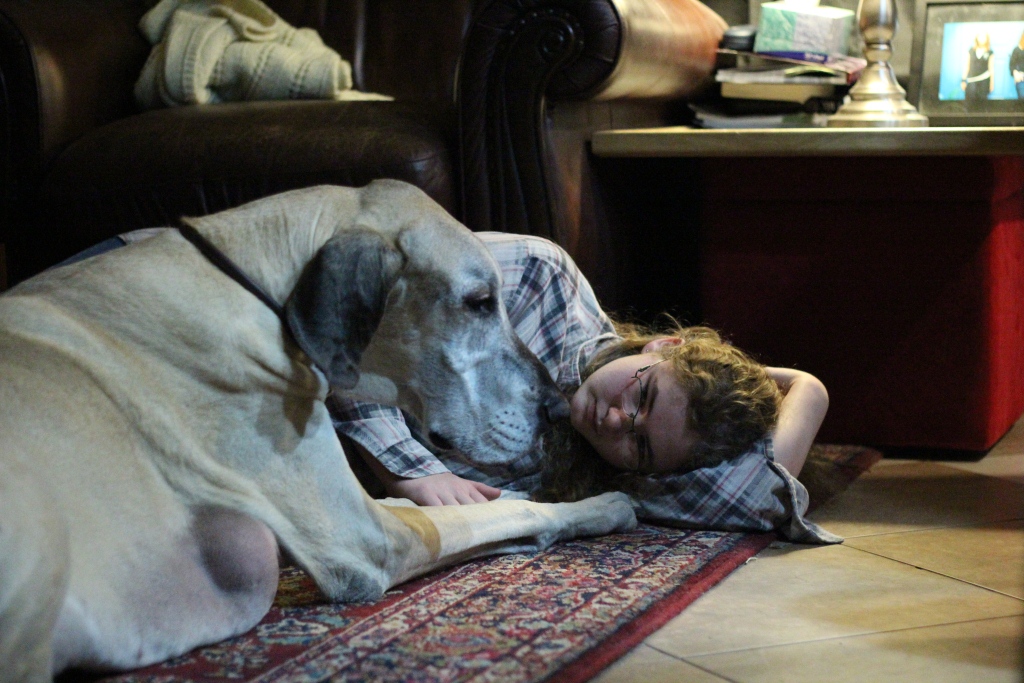- Home Page
- About Us
- Welcome To My Site
- Before you Buy a Dane
- Puppies and Adults
- Boarding
- Classes & Seminars
- Dane Care/Training
- Adaptable
- Crates-A Necessity
- Cropped Ear Info
- Danes and Children
- Frequent Questions
- General Training Info
- Grooming
- Helpful Vet Supplies
- If You Die......
- Living With Old Danes
- Puppy Care
- Show Training Your Dane
- Socialization
- Space Etiquette for Dogs
- Stressed Dog Management
- Temperament
- Two Puppies Together?
- Vet Med
- Home Page
- Dog Show Handling
- Great Dane Information
- Guestbook
- Items For Sale
- Our Dogs
- Sitemap
- Tips
- Search This Site
- Logan
- Tayo
- Stud Dogs
- Leo
- Medical Devices
- Fact & Fallacy
- Pet Transport
Daynakin Great Danes LLC
Est. 1974
Championship Quality AKC Fawn & Brindle Great Danes
For Show, Performance and Companionship
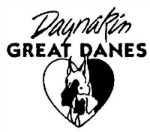
Living With Old Danes
LIVING WITH SENIOR GREAT DANES
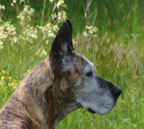
By Georgia Hymmen
Dogs lives are too short.
You know the pain is coming, but there’s such beauty in the hard honesty of that,
In accepting and giving love while always aware that it comes with an unbearable price.
Dean Koontz
Then, seemingly overnight our vibrant active Dane gets old. We notice more grey on the face, a slower step, and some stiffness is evident. Our beloved Dane has reached his senior years.
I think anyone who has shared their lives with a senior Great Dane will agree the golden years are the most special and treasured times with our beloved breed. Senior Great Danes have wisdom not present in their younger counterparts. They understand us and can seemingly read our minds. They know when we want to play and go grab the toys or when we are sad and need their quiet, comforting presence. They alternate between being regal and dignified to silly and making us laugh. Those Danes who have been mothers are always mothers and assist raising subsequent litters, teaching the new youngsters all the house rules. They know our routines and ask so very little of us and make even less demands. Food, love, attention, a leisurely walk or car ride, a comfortable place on the bed or couch and they are content.
Unfortunately, the road from a mature, vital adult to the inescapable Rainbow Bridge can be a bumpy one. Some Danes who grow old at a young age are fraught with problems early on and decline quickly; others age gracefully and continue to be active and mobile to their last days. Genetics, care and fate will all play a part in how an individual Dane ages. We, as their caretakers, can help make the journey through the autumn of their lives safe and comfortable. It is our duty, for their many years of companionship, to treat them with compassion in this journey.
Keeping Them Healthy
Performing a weekly “hands on” exam of your senior once a week will keep you on top of his physical condition and any changes that might occur. You should carefully run your hands over his entire body and limbs, looking for any lumps, bumps, tenderness or hot areas. Examine the teeth and gums carefully as teeth caked with tartar can become a big problem. A dental cleaning should be discussed with your vet; anesthesia can be a concern with our older Danes.
Routine geriatric veterinary exams are an important part of your aging Dane’s health. A veterinary exam geared for older dogs, by a Dane-savvy vet, will help to identify and treat any emerging diseases and help you deal with them appropriately. A geriatric blood panel can be invaluable in helping to identify problems. Regular exams will allow minor issues to be treated before they become major. Serious problems can be treated as appropriate, to make the dog comfortable, and to allow the owner to prepare for the inevitable.
Diet and proper exercise are very important for the older Dane. A quality diet allowing for proper nutrition and weight supervision is imperative. Fat Great Danes have a harder time moving around as they get old, plus the extra weight is hard on their joints and other body parts, and besides simple management, it’s very unhealthy.
Low thyroid is a not-uncommon reason for weight gain in senior Danes, and can be easily managed with a low-cost thyroid prescription. Additionally, diet can play an important part in management of the fecal-incontinent dog, a very common old-Dane problem.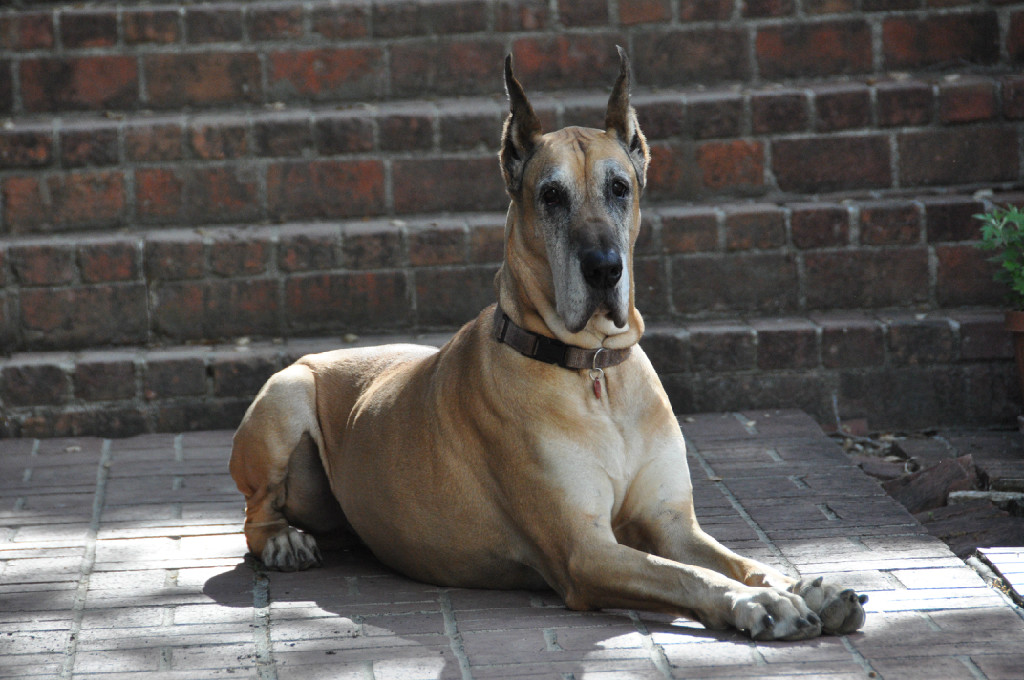
As long as they are capable, old Danes should partake of some type of appropriate exercise. Care should be used to make sure it’s within your Dane’s specific limitations; but lounging on the couch all day with little activity allows them to lose muscle tone and makes movement all the more difficult. An easy walk around the neighborhood or yard might be all your Dane can do, but it will be good for the both of you—he’ll get some exercise and fresh air and you will share precious one-on-one time with him. For some dogs, with veterinarian approval, swimming or going to a canine pool can have great benefits.
Your aging Dane may have needs specific to his or her aging process and as an astute owner you can identify these needs and make the aging process as comfortable as possible.
Make It Easy For Them
Danes, just like humans, start to experience instability and balance issues as they age. Jumping on the bed or leaping into the car was once so easy and now is difficult, if not impossible, for the senior Dane to accomplish. Simple things like walking across a slick floor can be unmanageable. Household objects that once were of no concern now become major obstacles, especially in Danes with failing eyesight.
We as humans can do many things to make our Danes safe and comfortable. Slick floors can be covered with non-slip rugs (and who cares if they hide your lovely flooring). Beds and vehicles can be accessed by ramps. (The astute Dane owner will have taught his Dane at a young age how to navigate them so as a senior dog he doesn’t have to figure it out.) A properly fitted and padded harness can allow the human to help with navigation issues and also prevent putting undo strain on fragile necks.
If you have a Dane with failing eyesight, don’t rearrange furniture. An older Dane may be more susceptible to cold so a coat may be warranted for outside time.
If you have multiple Danes, you may need to supervise, or even curtail, rambunctious play with the other dogs. A dog with bone cancer can be very fragile and rough-and-tumble play could result in the affected bone fracturing. While you want your Dane to continue to have interaction with the other household dogs, use good sense and don’t allow rough play.
Aches and Pains
Canine or human, we all get aches and pains as we age, and the most common cause is arthritis. However, humans can tell caregivers how we feel. Our Danes don’t have that luxury, and due to their stoic nature, may well be in a great deal of pain before actually exhibiting signs.
Some signs are obvious--limping of course should immediately be checked out by your vet. Osteosarcoma is sadly a frequent and unwelcomed assailant of our beloved Danes and any kind of limb lameness should be carefully checked out. Other signs are more subtle and the newer Dane owner may have problems interpreting them. Signs of pain could be a Dane who used to love to play with other dogs now avoiding them or even acting aggressively when other dogs approach; he’s afraid they will bump into him and injure him. A dog now hesitant to load up in the vehicle isn’t being stubborn, but instead doesn’t want to because he knows the action will cause him pain. Ignoring basic commands like sit could also simply be because sitting causes pain.
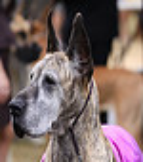 For severe pain, stronger medications are available. Many owners feel their Danes get relief from supplements. Popular choices are Phytoflex and MSM. Both are popular with many Dane owners and are considerations to discuss with your veterinarian. It is important to discuss the use of all supplements and medications with your veterinarian, as the dose/ combination and effect of various drugs may be affected by old age. (Some medications can be pricey, so discuss options, such as human generic equivalents, with your veterinarian. Also check online reputable pet pharmacies for the best prices for long-term prescriptions. This is also when pet insurance can come in very handy.)
For severe pain, stronger medications are available. Many owners feel their Danes get relief from supplements. Popular choices are Phytoflex and MSM. Both are popular with many Dane owners and are considerations to discuss with your veterinarian. It is important to discuss the use of all supplements and medications with your veterinarian, as the dose/ combination and effect of various drugs may be affected by old age. (Some medications can be pricey, so discuss options, such as human generic equivalents, with your veterinarian. Also check online reputable pet pharmacies for the best prices for long-term prescriptions. This is also when pet insurance can come in very handy.)“Alternative” and holistic treatments may also be an option. Some Dane owners have felt their dogs receive a measure of relief from acupuncture and chiropractic care. Canine massage also should be a consideration.
Being Prepared
One of the biggest (no pun intended) problems with our breed is if they go down and can’t get back up on their own, it can be very difficult (if not impossible) to lift or move a large Dane All Dane owner should have a belly sling that can be used should this happen. The owner would also be wise to have a game plan in place if their Dane does go down or falls and can’t get up: Can a friend or neighbor come and help? Is there a mobile vet who can come to the house? Think about this as unfortunately it’s a common problem with old Danes.
Common “Old Dane” Problems
Rear-end Instability and Incontinence
A frequent and common problem with older Danes is rear-end instability and the fecal incontinence that goes along with it. Any Dane who lives long enough (to six or so) is going to develop spinal degenerative disease to some extent. The degenerative changes occurring in the spine interfere with the messages the spinal cord gets. Some get the disease at the “young” end of aging, others not until they are quiet old. People who are not familiar with this rear-end weakness and instability sometime assume there is something wrong with their dog’s hips or knees but rarely is that the case. The dog’s rear may start to give out, giving a “sinking” appearance when standing for a long time, or he may have problems navigating slick surfaces and difficulty getting up and down.
The most obvious (and distressing to human) symptom is the signature “poop bombs,” where the dog defecates, without realizing it, when getting up or simply walking across the room. This can be a difficult disease to deal with, because mentally the dog is fine and generally not in pain. The problem comes with the fecal incontinence and the fact the dog really doesn’t have a clue he’s pooping—and frequently this in the house or while he’s sleeping. Many Danes, once they’ve realized what they’ve done, appear quite horrified. Dogs that are clean by nature can become quite upset. Consultation with a vet is advised; however, medically there is little that can be done.
Management of this type of rear-end instability is usually the only option. Sadly, as the Dane gets older, the rear instability gets worse; frequently to the point where the dog can no longer stand or get up. (The loving owner will consider the dog’s best interest to prevent them from reaching this point of helplessness – a hard but loving decision that is discussed later in this article.)
Some management options include:
- Feeding a diet (such as raw or grain-free) that results in small, firm stools.
- A regular feeding schedule combined with planned outside time.
- The use of a rectal suppository to encourage bowel evacuation.
- With veterinary approval, the daily use of Metronidazole.
- Taking the dog outside and be sure he has “moved around” and had a little bit of exercise, which sometimes helps prompt defecation.
- Placing covers (even sheets work) on couches and floors where the dog frequents.
- When unsupervised, keeping the Dane in a confined area or a large exercise pen, in order to contain an “accident.”
Sometimes urinary incontinence is a problem, either in conjunction with the fecal incontinence or separately. Both male and female dogs frequently respond to treatment with phenylpropanolamine (PPA); if the dog doesn’t, diethylstilbestrol can be tried. For cleaning and eliminating odors, special urine cleaners are now available in pet stores. If you suspect a spot but can’t pin down where to clean, use a “black light” to show up urine spots.
Lumps and Bumps
Many older Danes develop lumps and bumps on various parts of their body. While all should be checked out by your veterinarian, thankfully the vast majority are simply lipomas (benign fatty tumors) or sebaceous cysts. These tumors can be unsightly, but they generally do not cause any problems. Sebaceous cysts can sometimes rupture and if that happens, will need to be treated. However, with any lump or bump there always is a chance of cancer so the appropriate testing should be done on any that show up.
The Dreaded “C” Word
Cancer is the number one killer of dogs, and sadly our Danes are prone to osteosarcoma simply due to their size. (Any large breed is prone to bone cancer; one thought is the larger size puts more stress on the bones making them more susceptible to the disease.) Other cancers such as lymposcarcoma, fibrosarcomas and mast cell tumors can also attack our beloved Danes.
Immediately have your vet check out any lameness your senior Dane may exhibit. Should your Dane be afflicted with this terrible disease, you will have some difficult decisions to make. Treatment options include amputation, chemotherapy or just management to make the dog as comfortable as possible. Usually, by the time bone cancer is diagnosed, it has already metastasized to other parts of the body. The natural instinct of a loving owner is to “fight” the cancer – to do “all you can.” Doing less can be hard, but sometimes simply managing the symptoms, to ensure your beloved companion is not in pain, is really the best thing for your senior Dane.
Enlarged lymph glands, especially throughout the body, can also be cause for concern and should be immediately checked out, as should anything that just doesn’t “seem right”.
Heart Problems
While heart problems can occur at any age, sometimes they show up in the older Dane. Again, symptoms can be subtle and often attributed to simply the aging process. A slower demeanor, a fuller abdomen, shortness of breath, a bit of a cough—these all could be signs of heart problems. Some problems can be helped by medication, others not.
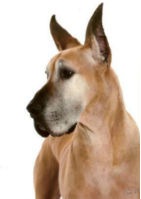
Bloat/Torsion
Of course, Danes can bloat at any time, but it seems that a significant number bloat when they are older. My experience has been when an older Dane bloats there frequently is another problem going on such as cancer, liver disease or something else serious. Sometimes you know about this problem, other times you don’t. As we know, prognosis for bloat (torsion- GDV) surgery can be very good IF the bloat was caught soon and the dog is strong and healthy. (Stomach torsion is most common and has severe and dramatic symptoms. Older Danes can also suffer from torsion of the spleen, which can occur over a longer period with more subtle symptoms, but it is also an emergency, with the risk, and surgery decisions, the same.)
Whether or not to do surgery on an older Dane in active bloat is a personal decision. Whatever your choice is, it should be made in advance so you do not have to make a difficult decision at 2:00 a.m. in the waiting room of the emergency vet. If you are leaving town, be sure your dogsitter, and your vet, have your wishes about surgery in writing. If torsion strikes and you cannot be contacted immediately, ensuring that your sitter and vet know what you want to do will protect your senior Dane.
Other Problems
Liver and kidney disease, diabetes, and a myriad of other afflictions can attack our Danes as they age. Anything that seems out of the norm, such as increased thirst and urination, a change in temperament, re-occurring vomiting, odd wheezes or coughs and such should warrant a trip to the vet.
Saying Goodbye With Compassion
Saying goodbye to a beloved Great Dane can be one of the hardest things you’ll ever have to do. Very few of our Danes gently slip into their final sleep. Most need peaceful guidance to go to the Rainbow Bridge to wait for us. Knowing when the time is right is the last act of kindness you can offer your friend. At times, it’s hard to know whether to do treatments for a terminal illness, such as cancer, or to simply make your dog comfortable and let go when the time comes. A good philosophy is to do what is best for the dog, without causing harm, suffering or undue pain. If an invasive surgery or treatment is going to require extensive recuperation and the prognosis is to only perhaps gain a month or two—do you really want to do that to your dog? And who are you doing it for?
When to let go is very hard on us humans; we always want to second-guess ourselves. One good day, even if preceded by several bad days, gives us hope. We know the end is near, we just don’t want to acknowledge it. However, your Dane will give you signs -- the first being losing interest in food, especially if the dog was a chow-hound. Other signals that tell you it’s time to let go is the look in their eyes: You may see pain and the gentle plea to make it stop. Or you may simply see that the “spark” is just no longer there. We as humans have the dubious luxury of ending their suffering.
Those of us who have been in the breed for many years have all made the mistake of simply waiting too long to let go; it’s so hard, and we just can’t bear to euthanize a loved and cherished friend. Don’t let your emotional needs interfere with what’s right for your Dane. Let them slip from your life pain-free and while they still have some dignity of life. Try to take some solace in the fond memories and pleasure you had with your beloved pet.
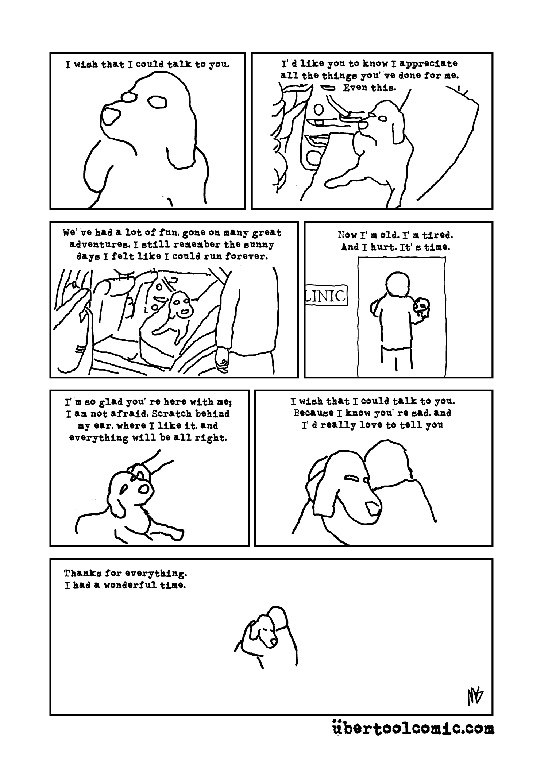
Authors note: I would like to extend my thanks to the many people (too numerous to list) who offered suggestions for this article. It was an especially difficult one to write, as I had just found out my senior, Josie, has bone cancer. As hard as it is to lose our Danes, the years of special love and joy one does have with a Dane, especially an older one, is worth the grief one feels with the loss. (Feb. 2013)
